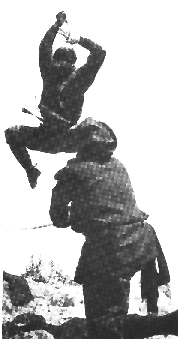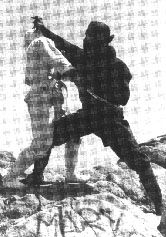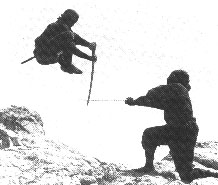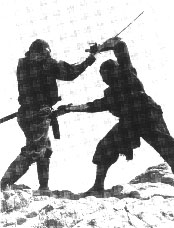
The Best of Black Belt Ninja Magazine - (Issue Number One)
Over 1800 years ago in Korea, there sprang a group of brave
warriors who became renown for their expertise in the areas of spying and espionage.
These men, known as the sulsa, created an art which is still being practiced
the same way today as it was when it originated in the kingdom of Silla. 
Throughout the course of history there have been those individuals and groups that because of their unequaled bravery and courage in military situations, have left their mark in their nation's history books. The knights of medieval England, the kamikaze pilots of Japan and the revolutionary soldiers of the United States all had special military prowess and therefore had a tremendous impact on their respective countries. In Korea, a country rich in martial arts tradition, the Hwa Rang warriors made such an impact. These fearless warlords who sought truth and beauty were commonly known as the "flowering" or "wandering" knights. They studied their art initially in an attempt to become more attuned with the universe but it developed into a way of life that has lasted over 1800 years. The birth of this style in the United States can be attributed to several factors, one of the most important being the dedication of the system's current head, Hwa Rang Do® Founder Dr. Joo Bang Lee and only governing organization World Hwa Rang Do Association. Lee exposed Hwa Rang Do to American servicemen in Korea in the early 60s and then brought it to this country in the 70s.
From the vast pool of combative disciplines taught in Hwa Rang Do emerged a unique, dark and mysterious sect of fighters, the sulsa. The sulsa specialized in infiltration of enemy camps in order to obtain key military information for their lord or government. They were specially trained, highly skilled fighter similar to the United States Green Berets. The sulsa were experts in the study of trickery and diversion, killing techniques, kidnapping and survival, who used whatever means was necessary to accomplish their mission. The creation of the sulsa was born because of the political atmosphere in Korea.
Korea, 1800 years ago, was divided into three kingdoms: Koguryo,
Paekche, and Silla. Silla (where Hwa Rang Do originated) used the sulsa to understand
the strategiesand tactics of warfare utilized by the generals of Koguryo and
Paekche. This time in Korean history is often refered to as the warring period
where battles, war and killing were a way of life. Invasions came from the north
by Koguryo with the help of Tang's armies (as China was called), from the south
and east from the Japanese samurai and from the west by the Paekche with their
small but powerful forces. At times, Manchurians, Mongols and even the troops
from what is now the Soviet Union trampled through Korea, but they were ultimately
defeated by Silla's generals who were all sulsa warriors. 
The sulsa trained in two aspects of warfare: 1) Jeong Do - the way of the true sword which was characterized by fighting with honor and dignity. This is a straightforward way of mental focus and does not require one to deceive, but rather to overwhelm the enemy. 2) Am Ja-the study of combat in which trickery, diversion, deceit, stealth and camouflge are the key factors utilzed in defeating the enemy. The sulsa used any method to claim victory for his side.
Silla sent their sulsa into Koguryo and Paekche to integrate into their cultural and social environment. After being accepted into the main stream, the sulsa would wait patiently for a sign to carry out a predetermined mission. This sign could come in the way of an arrow with a message attached, a fire on a distant ridgetop, smoke signals, or secret rendezvous. After the mission had been accomplished, the sulsa would return to Silla with the head of his conquered victim, secret documents or information, or kidnapped prisoners. Sulsa were known to travel at incredible speeds and it was said that they were able to walk on water. In some instances, they were even said to be seen flying across the sky. These accounts are exaggerated but the sulsa did develop some incredible techniques to aid themselves in their mission.
There are special techniques in Hwa Rang Do that teach one to travel light by using certain breathing techniques coupled with the focus of ki power. The sulsa utilized the terrain to their best advantage; becoming masters at camouflge. The stories of them walking on water can be attributed to the technique termed Jham Soo Sul. This technique allows one to survive under water for extended periods as well as traveling on or in water. Their special equipment included boots containing large air sacks and large wooden buckets which when they put on their feet allowed them to walk on the water.
The acrobatic skills of the sulsa could probably justify the
accounts of sulsa being able to fly. Sulsa would often leap from tree to tree
or rooftop to rooftop utilizing ropes and special equipment and techniques for
leaping and tumbling onto high places as well as landing on them. 
The sulsa, much like the ninja, were the top athletes in the country. They were able to accomplish athletic feats which most other people could only dream about. Sulsa training was extremely grueling. Their study began at an early age, around six years old, and continued into their teens. Each segment of sulsa training was taught with the idea that it was a life or death situation they would be involved in. Training included: Learning how to live off the land, using the terrain, camouflage techniques, and learning how to use weapons such as knives, swords, and staffs. Along with the physical training came the mental toughening process, teaching the young sulsa to keep calm in a pressure situation, to excel in places where others would certainly fail.
Another key element of their training was the learning of healing techniques. The sulsa believed that if they were involved in the killing aspect of the universe, they must also know the healing aspects. Every sulsa studied herbal medicine, basic first aid, and survival techniques which were all part of their daily training. They became experts at curing all types of ailments, which helped not only themselves but their fellow countrymen as well.
Uniforms worn by the sulsa varied, depending on the situation that they were involved in. Whatever costume best aided them in blending into a particular culture is what they wore. The most famous outfit is probably the black espionage outfit which is similar to the ninja with the exception of the hood. Unlike the ninja, the sulsa's headpiece is one three foot by three foot piece of cloth which when not being worn to hide its wearer's identity, was used as a carrying bag for things such as weapons, stolen documents or even the head of his latest victim.
The sulsa were also well verseed in the basic martial arts techniques. All types of punches and kicks were taught to the warriors in order to insure that they were prepared for every situation.
Like ninja history, documentation of some of the great sulsa of the past is difficult because of their secretive nature. However, stories were passed down from one generation to another featuring tales of some of the great sulsa of the past.
One of the most reknowned hwarang was a youth named Kwan Chang
(645-660 A.D.) who risked his life for the honor and glory of his kingdom. He
demonstrated one of the five commandments that the famed Buddhist priest Won
Kwang Bopsa laid forth for all of hwarang and the laymen to follow. This ethical
code is sa kun e chung (loyalty to one's country [king]). The sulsa and all
hwarang would risk their lives for the survival of their country. To them "life
is like a feather, and loyalty is like hard steel." 
Kwan Chang, at the age of 15, gained high rank and respect among the hwarang and was ordered by King Muryol (654-661 A.D.) to infiltrate and assassinate a Paekche general, Jua Jang Gun. Using sulsa techniques, he was able to go into the kingdom of Paekche where he entered into their lifestyle. King Uija, the reigning king of Paekche, invited Kwan Chang to perform and entertain for him and his court. Kwan Chang who had disguised hinself as a dancer, had become popular among the townspeople. He performed a form of two short swords (ssang gum sul hyung which was modified into a dance). At the end of the performance Kwan Chang killed the general and escaped from enemy territory. Upon returning to Silla, he was praised and awarded by King Muryol for his bravery and cleverness. The ssang gum sul hyung which Kwan Chung used to kill the general became a traditional folkdance called ssang gum moo which is still performed in Korea to this day. This story of Kwan Chung is just one which displays the skills and cleverness that a sulsa must have at all times in order to accomplish the treacherous and difficult military missions they were given.
Another such story (translated from the Korean historical book - Sam Gun Yoo Sa) concerns the legendary General Yoo Shin Kim (595-673 A.D.). The 12th generation descendant of the Kaya Country King Soo Ro Kim - Yoo Shin Kim became a Hwa Rang at the age of 14. He had 5000 Rang-Do under his control and at age 18 attained the rank of kukson, top commander of the military forces of Silla. An accomplishmed sulsa, General Kim would often infiltrate into Koguryo and Paekche with other Hwa Rang sulsa to receive information regarding opposins battle strategies.
One legendary story of the sulsa concerns General Yoo Shin Kim
and a double agent named Baek Suk. According to legend, Baek Suk was a Rang
Do who had trained for a couple of years when he approached General Kim with
the hopes of joining him on a sulsa mission for information into Koguryo. On
the trek to Koguryo, the men stopped at an eating and resting place in Gol Hwa
Chun (now Yong Joo). Two beautiful women attendants seved the men meals and
asked them where they were traveling. When it was disclosed that they were in
search of information concerning Koguryo, a third woman joined the group and
whispered to General Kim to follow the three women alone to a nearby place.
He went with them and saw them transform into three goddesses (Nae Rim, Hyuel
Lae, and Gol Hwa). Collectively they represented the goddesses concerned with
the defense of the country (Ho Kook Shin). The goddesses stated that they wished
to confer with General Kim alone because there was an enemy in his ranks - a
double agent who was in fact a Koguryo spy. They talked, then disappeared. 
Feigning the omission of an important document, HwaRang General Kim returned with his group to the Silla headquarters. Once home, He interrogated Baek Suk, who admitted that he was in fact a spy from Koguryo. When asked the reason for his treachery, prior to his execution, Baek Suk replied with the following story:
There was a fortune teller who lived on the border of Koguryo and Silla named Choo Nam. The King of Koguryo had sought Choo Nam's services for another matter and was told of some indiscretions his wife had committed. With his wife being upset by this news, the king decided to test the powers of Choo Nam, to see if in fact she was a legitimate foreseer of the future. The king placed a mouse in an enclosed box and asked Choo Nam the box's contents. Her reply was eight mice. Obviously wrong, the king decided to take Choo Nam's life, though Choo Nam knew the contents but had the numbers incorrect. When asked again, Choo Nam replied with the same answer and said that if put to death, upon reincarnation into the next world, Choo Nam's spirit would come back as a general to overtake and defeat Korguryo. The king of Koguryo put Choo Nam to death. Still curious however, he opened the mouse and found seven unborn mice in its womb - a total of eight mice. Distressed by this turn of event, the king later dreamed that Choo Nam's spirit had entered the womb of General Yoo Shin Kim's mother. He later dispatched Baek Suk to eliminate General Yoo Shin Kim but Baek Suk found him to be too powerful to do so; therefore thought to accompany him into Korguryo where, with the help of other accomplices, General Kim could be killed or detained.
These are but two of the innumerable stories concerning the legendary hwa rang warriors of ancient Korean history. Like all legends there may be some amount of exaggeration in these stories however, the deeds of the original sulsa were truly noteworthy. They established a tradition which is the foundation for today's Hwa Rang Do followers.
The transition from ancient times to modern day is a natural evolution. Even in our fast-paced world - a world far more complex than in ancient times - the need for dedicated individuals with nerves of steel who can think, act, and give undying loyalty to their country still exists. The mission of the hwarang sulsa remains the same as it has for centuries - living for the service of one's country.
The training schedule of today's modern sulsa is as rigorous as their predecessors. It has to be, for it is indeed as much of a life or death situation today as it was back in the kingdom of Silla. How earnestly and efficiently one practices can only help to ensure your own survival and the mission's success. Utilization of modern technology is merged with the ancient spy - counterspy espionage to form the most advanced methods of training available. With today's constant undeclared war on terrorism there is a constant need for the development and updating of technology. However, the game still remains the same as it has been for centuries - those who are best prepared for the battle will emerge the winner.
Dr. Joo Bang Lee has taught selected individuals in this secretive
side of Hwa Rang Do. One of the most noted modern day sulsa was the late Michael
D. Echanis, former chief instructor of the Special Warfare Branches of the United
States Military Armed Forces. Echanis authored two volumes on the following
subjects  which
are available through Ohara Publications - Special Forces / Ranger-UDT /
Seal Hand-to-Hand Combat / Special Weapons / Special Tactics Series; Basic Stick
Fighting for Combat. Certain instructors from the World Hwa Rang Do Association
are currently teaching special elite units of the U.S. Military Forces in this
aspect of the art as well as selected individuals in specialized law enforcement
agencies.
which
are available through Ohara Publications - Special Forces / Ranger-UDT /
Seal Hand-to-Hand Combat / Special Weapons / Special Tactics Series; Basic Stick
Fighting for Combat. Certain instructors from the World Hwa Rang Do Association
are currently teaching special elite units of the U.S. Military Forces in this
aspect of the art as well as selected individuals in specialized law enforcement
agencies.
It is important to note that sulsa (in ancient times as well as in modern) live by a code of ethics inherent in the martial arts of Hwa Rang Do. They should not be confused with mercenaries or individuals who are truly hired assassins.
This code of ethics not only guided the sulsa of the past but also guides the present day followers. They are the commandments that every practitioner involved in Hwa Rang Do uses to help him through daily life. It takes a person of great mental discipline, concentration, and patience to undertake and live by such a code. The development of such character was and still is the cornerstone by which every sulsa lives. For in Hwa Rang Do it is believed that learning these techniques is the only way to discover the moral order of the universe.